Brazilian aircraft carriers. Past. The present. Future
The aircraft carrier Minas Gerais, of course, was not a new ship at this point. He entered the British fleet as HMS Venegance in 1945, he even went to the Pacific to fight the Japanese, but he did not. Until 1952, Vengens went under the British flag, then not for long - until 1955, under the Australian, and was leased there. Upon returning the ship to Britain, he was found a new permanent owner - Brazil, where he received the name "Minas Gerais", in honor of one of the states of the country. It is said that the aircraft carrier became the “carrot” for the Brazilian sailors from the newly elected president of the country: otherwise the fleet was preparing to make a mutiny! But the “toy” was received, and the matter did not come to fights between the army and the Air Force on the one hand, and the fleet on the other, as it happened in neighboring Argentina.
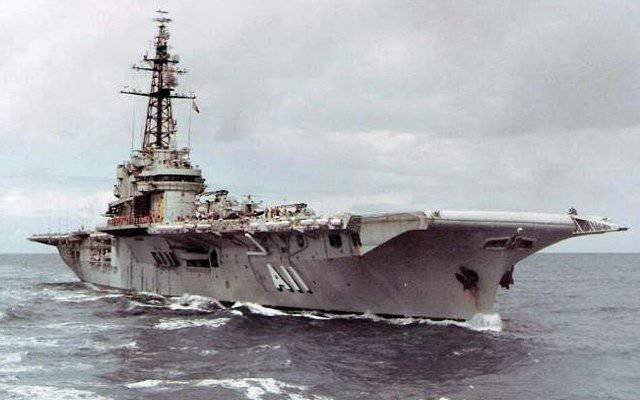
It is interesting to compare the fate of the “Minas Gerais” with the life story of “Vikranta”, especially since initially these ships belonged to the same type of Colossus, and the new owners fell almost simultaneously.
Like the "Vikrant", before the transfer to the new owner, "Minas Gerais" was upgraded with the installation of a steam catapult, corner deck and other things. But the Brazilians ordered the alteration not to the English, but to the Dutch, but on the dates - three years - this was not too reflected. In 1961, the ship arrived in Brazil.
The formation of the air group Brazilian sailors took seriously, but slowly. The main task of the ship was considered to be a patrol of the economic zone of the country, therefore, first of all, it was supposed to buy modern for those times patrol-anti-submarine "Trekkers". But first it was necessary to prepare native cadres: both deck crews and pilots. And here the Brazilians get three old torpedo-carriers TBM-3 Avenger (American made, but through the French), and then six training decks Hamilton Aircraft T-28R-1 Nomair. The latter was a specific version of the North American T-28 Trojan training aircraft, converted from US ground-based T-28A decommissioned specifically for the Brazilian fleet.
Alas, then everything went as in the Brazilian TV series. Only dona Marina healed in a human way, as immediately, Doña Forsa Aerea began plotting against her, who persuaded Don Umbertu to deprive her opponent of her jewelery on suspicion of infidelity. Yes, yes, it was so! Dona Marina is the Marinha do Brasil fleet, Dón Forsa Aeroa is Forca Aerea Brasileira, BBC, and Don Humberto is Umberto di Alencar К Castel Braunco, the then president of Brazil, who issued an 1965 decree depriving the fleet of all aircraft and transferring them to the BBC. The idea was that if the fleet ever rebelled, he would not have airplanes, and with the help of the Air Force of freedom-loving sailors will be able to quickly pacify. And the South American sailors are really great champions of democracy, and dictatorships (especially without their participation) have always and everywhere been treated with great suspicion.
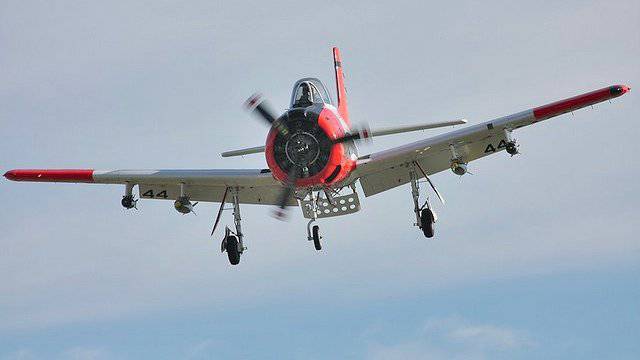
The “Nomairs” of the Air Force were transferred to the coast, having decided that it was not worth spending energy on self-training of deck pilots, and it is easier to send them to study in the USA. From the United States by that time the “Trekkers” arrived, which for many years were the only aircraft flying from Minas.
The situation with the air group became anecdotal: on one ship there were two of them - one from the Air Force on the “Trekkers”, the other from the fleet, on helicopters. This continued until 1987, when the catapult broke down on the ship. Spare parts could not be obtained, the planes were sent ashore, and only naval helicopters remained on board.
But there was no happiness, yes helped someone else's misfortune. The Argentines decided to write off the aircraft carrier of the same type 25 de Mayo and agreed to sell the catapult from the northern neighbors. In the year 1996, breathing "Trekkers" appeared on board again, their lifespan coming to an end.
But the times of the degrading of Marina Marina came to an end. Improving the country's economy gave money that was previously not enough, and the democratization of the political sphere reduced the possibility of a naval rebellion to zero, better than any threats. And as dona Forsa Aeréa did not oppose, the new president of the country, don Fernand Enriki Cardos, lifted all restrictions on acquiring aircraft for the fleet. When Don Henrique fleet tried on board the Minas, Argentine "Skyhawks", found them suitable and in 1999, purchased in Kuwait 23 single and double A-4KU.
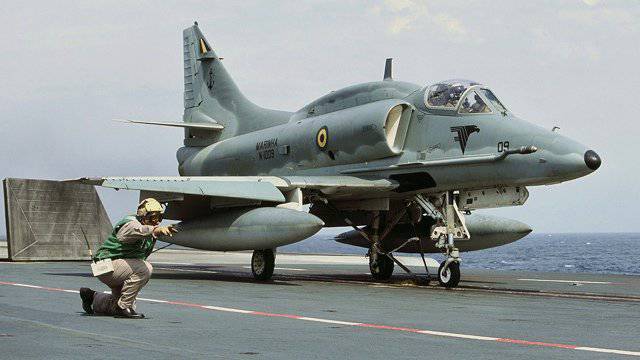
The aircraft were built in 1977 year, but were in very good condition - both because of the dry climate of Kuwait, and because of the low intensity of use. Machines, along with spare engines and weapons, cost the Brazilians just 70 millions of dollars - a very good deal!
As an alternative, it considered the purchase of Sea Harriers in England, but the sailors understood that if you take them, you will have to forget about normal aircraft carriers and a full-fledged air group in the foreseeable future. And, unlike the Indians, they put on the ejection takeoff and aero-finisher.
The planes, which received the designation AF-1 Falcao, did not happen to fly long from the Minas Gerais: the ship was already too old (at that time the oldest aircraft carrier on the move in the world) and it was expected to be written off. But the presence of the “Falcons” played a role: there was no talk of any “Harrier Bearers” and other miseries. And in 2000, the Brazilian sailors were already rubbing their hands — they would have a new aircraft carrier to replace the Minasa!
The new Brazilian aircraft carrier, of course, was again not entirely new, and plowed the seas and oceans from 1963. Built in France, where Foch was called, he was with his senior sistership Clemenceau, perhaps the most successful light aircraft carrier in the world. These ships are similar in size to the same “Hermes” - “Viraat”, but were initially made with a corner deck, steam catapults and other attributes of a modern aircraft carrier, which made it possible to use the saved displacement to accommodate equipment and the air group.
In general, the Clemenceau-type ships housed up to 40 aircraft, such as the F-8 Crusader supersonic interceptors, Super Etendard fighter-bombers, Etendard IVP reconnaissance aircraft, and Alize anti-submarine patrols. These are real multipurpose ships that were widely used in “peacekeeping” operations.
The French have written off the Clemenceau ships both in age and because of the need for their sufficiently large-scale modernization to work properly with the newest Rafale M. fighter-bomber aircraft. Alas, only one Charles de Gaulle was built for replacement, the second nuclear-powered ship not enough money.
The Brazilians didn’t scatter money either, but buying such a ship, and not rusting against the wall for a decade, but in combat-ready condition, but only for 12 million dollars ... But who will refuse!
So the Brazilian fleet received an aircraft carrier, and received almost instantly: 30 was announced on July 2000 of the year, 26 was issued on September, 15 in November of the same year was transferred to the ownership of Brazil under the name of Sao Paulo; 25 February of the same year went to the duty station. Togo six months. Not Vikramaditya, however ...
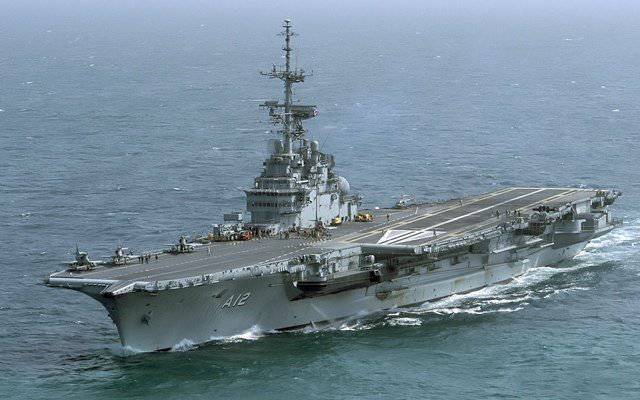
Oh, that “Sao Paulo” in its combat capabilities clearly exceeds “Viraat” - a fact. If we compare the old man with the "new" Vikramaditya, he will still look quite decent, thanks to the flexibility of the formation of the wing. The catapults on it are not the most powerful, but they are still catapults, not a springboard!
The Minas inherited from the new Brazilian aircraft carrier the Falcons - the Skyhawks (* AF-1 Falcao, aka A-4KU) - pretty good fighter-bombers. In 2009, a program for their modernization began - the Embraer makes overhaul, replaces the oxygen system, electrical equipment, installs new avionics and radar. The program included 13 cars, the first of which went on trial on June 17 this year. The exact characteristics of the Falcons after modernization are unknown, but they clearly retained the possibility of using short-range air-to-air missiles and guided and conventional bombs, and probably something else was added to this. Skyhawk is quite capable of dragging up to 4.5 tons of weapons - verified in Vietnam - and after installing a new filling, it successfully closes the niche of the deck attack aircraft. It is also suitable as a light fighter: in the 1960s A-4s were used on a number of American aircraft carriers precisely as fighters, and until the very end of the 20th century they participated in the training of naval pilots aviation The United States, portraying enemy fighters - and not always losing to the Tomkets and the Hornets.
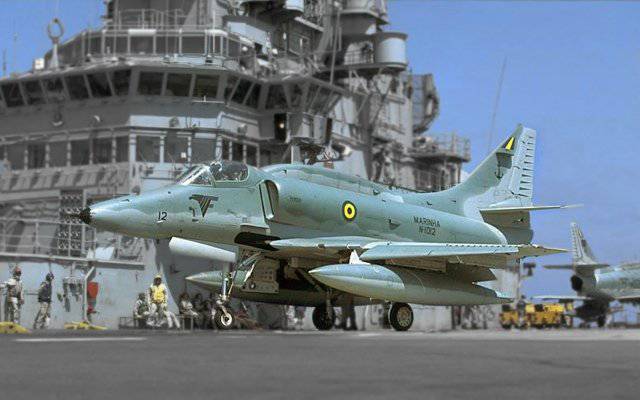
The training of Brazilian deck pilots is carried out in the USA (and you should not be ashamed of it - the proud French, for example, do the same), and the two-seat Falcons are used to “refresh skills”. Again, a good choice - pilots of the US naval aviation trained for several decades on similar Skyhawks.
Of course, the aircraft carrier has a solid selection of helicopters, both rescue and anti-submarine. But in the minds of Brazilians diversify and aircraft component.
The next step in the improvement of the Sao Paulo air group, in the opinion of the Brazilian admirals, is the receipt of tanker aircraft. Indeed, for long flights over the sea such an airplane is irreplaceable. The US Navy used to have specialized KA-3B Skywarrior, KA-6D Intruder tankers, then reduced S-3B Viking antisubmarine tankers to the role of tankers, and is now completely content with land-based tankers. But the United States, they have bases almost everywhere, and there are hundreds of land tankers. In extreme cases, the Yankees hang up refueling containers under the Hornet and Super Hornet fighter-bombers - although this is not very economical.
For the French "Charles de Gaulle" this is the only way - the French have never had specialized tanker refueling, there are few coastal ones, and the refueling container has had to be hung under the Etandards (Dassault Super-Étendard). The Brazilians are still doing the same: one Falcon fills the others, as the American Skyhawks often did during the Vietnam War.
Using warplanes to refuel other warplanes is not the best idea, but worst of all it is implemented in our country. That is, in Russia there are deck fighters, and special deck (lightweight) suspended refueling units, but how does all this work in practice? And without that, the take-off weight during take-off from the springboard is limited, and then the weight of the filling unit is added. At the Su-33, the UPAZ-1K unit designed specifically for aircraft carriers was not used in practice, the MiG, of course, is better in terms of weight, but still it turns out to be at least expensive.
It seemed wasteful to Brazilians to use even the Falcons to refuel. This at Kuznetsov and Vikramadity will have to be tolerated, and if there is a catapult and access to the US arsenals, more precisely to the storage bases, you can find something suitable. There were eight deck transport aircraft C-1 Trader, four of which are now returning to flying condition. Load capacity of the original "Trader" was about 3.5 tons - that is, less than the Skyhawk - "Falcon", but then it has much more space. In the course of the modernization, which cost 167 millions of dollars, the aircraft will be equipped with turboprop engines instead of piston engines, a new avionics unit will be installed, and a refueling unit will be installed in the fuselage. Cars designated as KC-2 Turbo Trader will also retain their transportation capabilities. Thus, in April 2014, the Brazilian fleet will receive the first two deck tankers, they are also transporters. It is also reported that "Turbo Traders" will be involved in fleet operations to paratroop special forces. The other two will be ready by October 2015.
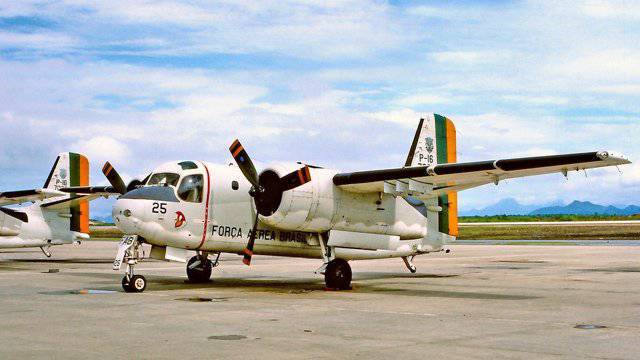
Both Russians and Indians can only dream about an aircraft with such capabilities, but without catapults on aircraft carriers, these dreams will remain unrealizable. And the South American sailors just had to wait a bit ...
Meanwhile, the Brazilians' imagination was played out in earnest. Yeah, our tankers will be, who's next? Logically - DRLO aircraft. Well, the platform - the same "Trader", perhaps - "Trekker" (Uruguay has some unnecessary), it remains "only" to put new engines and electronics. Eliradar HEW-784 and Thales Searchwater 2000 radars are considered candidates, the native Embraer should act as an integrator. Airplanes are very expensive - but such is the peculiarity of all DRLO machines - and the decision on them has not been made yet. But plans to acquire a couple of such machines are not discarded, but there are technical possibilities!
Again: neither the Indian nor the Russian aircraft carriers are not able to take DRLO planes, and the helicopter as a platform for the radar aircraft is noticeably inferior.
It is possible that the Swedes from Erikson will help the Brazilians with the radar, since their Erieye stands on Embraer R-99. But with what the Swedes have firmly decided to help the Brazilians, so it is with a modern carrier-based fighter.
Yes, “Falcon” doesn’t pull on such a role, but JAS-39 Gripen doesn’t. It remains only to adapt it to the ship-based.
The initiative in this belongs to the Swedes themselves, trying to find new markets for their aircraft. Theoretically, on the basis of the Gripen, which was developed with the condition of work from short runways, you can make a deck plane, strengthening the structure and chassis, as well as installing a landing hook. There is no doubt that the Swedish designers are able to develop such a modification. But who then to sell this Sea Gripen?
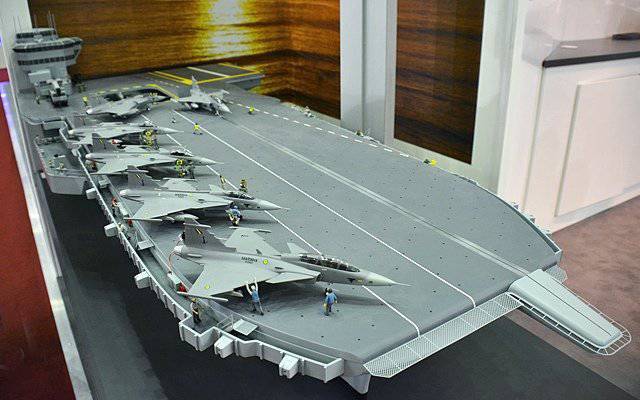
The Swedes themselves do not need a bastard, of course; the US and Russia do not need it. Britain abandoned the deck Eurofighter in favor of the American F-35, Spain and Italy are not going to build classic aircraft carriers, they are more expensive to sell to China. Only India and Brazil are left.
For both countries, the C Gripen (C Gripen) was offered complete with the usual Gripenes as the main fighter, but in India won the Rafale, and the acquisition of a large batch of MiG-29K closed the aircraft carrier theme for SAAB for the foreseeable time. Theoretically, the Gripen can be adapted to the springboard, but at the same time it will have to come to terms with a reduction in the maximum take-off mass by a third compared to the ejection start. So India, if she chose the Gripen for the new Vikranta, she would have made a bad decision. But will she benefit from the MiG-29K?
In the long run, for the Vishal and others with a catapult start, the Indians are likely to buy Rafali. But Brazil has everything ahead, and the Swedes have a fair chance of winning the fighter competition. Perhaps Gripen is not the best fighter in the world, but quite modern and inexpensive. It’s as if there is no one to fight Brazil, the aviation of the neighbors is small and / or equipped with old types - in such conditions, price is of great importance. Well, under a major contract for land fighters, it is possible to agree on a bridge. The official presentation of the Sea Gripen for the Brazilian Navy took place in April of this year.
The big problem is the cost of developing the "C" Gripen, according to some information, which is about a billion dollars, plus the actual cost of the aircraft. On the other hand, the Swedes are ready to provide Brazilians with very favorable conditions at Gripena in general. Here you can pay by installments for 15 years, and Embraer’s access to technology, and permission to independently develop new modifications and integrate new weapon systems, and to manufacture aircraft in Brazil, including for export. Saab is ready to give 80% of components for production in Brazil, and the possibility of selling Brazilian-made aircraft to third countries.
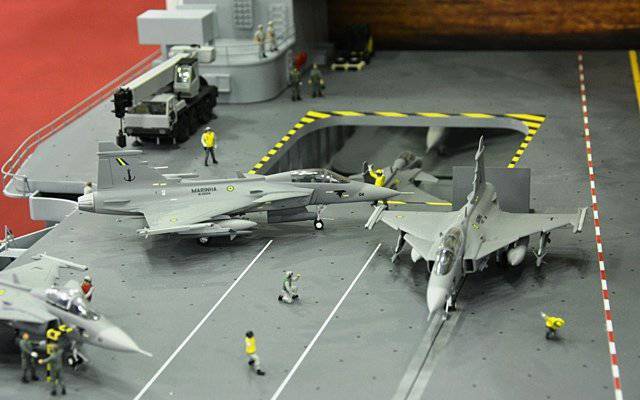
Counting on the favor of the Brazilians, the Swedes organized in Britain a special research center on the "Sea Gripen", where 35 people are working on the "loading up" of the aircraft. The center has already calculated that it will take 36 months to develop an aircraft in the metal, its cost from the state party will be only 250 million dollars. Some design surveys on marine modification have been carried out.
Whether the Gripen is an analogue of the MiG-29 or not is a difficult question, although it was tried more than once during international fighter competitions. It is also difficult to say what will be better - the “Si Gripen” or the MiG-29K. But if the Indians did not have to choose a plane, the Brazilians have a choice, and the Light did not converge on Gripen.
Seriously, the Brazilian sailors are eyeing the French "Rafal". Like the Gripen, the aircraft is offered for the competition by the Brazilian Air Force, and if it is chosen, it will increase the chances of acquiring a naval version.
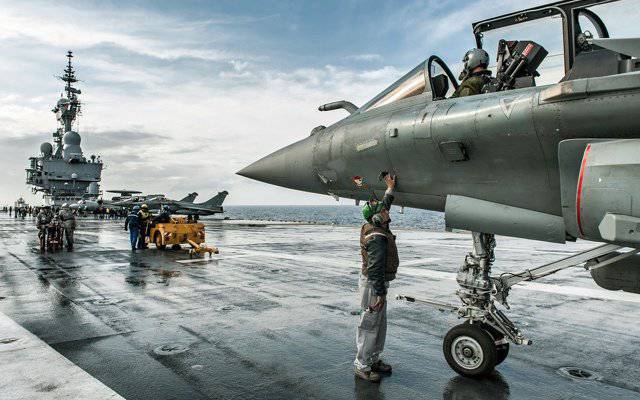
Deck Rafale M, however, is not too suitable for the “Sao Paulo” even though it was even specially modified for the flight of this fighter when he was a ship “Foch”. "Rafale M" passed on "Fosch" tests, and successfully, but is not able to take off from its catapult, even modernized, with a maximum mass. In practice, this means that the aircraft can only be suitable for air defense, but not shock operations.
The same can be said about a cheaper, but also a primitive alternative - the restored American fighter-bombers "Hornet" of early modifications. These vehicles can also fly from the deck of the "Sao Paulo" only with a reduced weight of the combat load.
As a result, the “Rafale”, that the “Hornet” are suitable only as pure fighters, but having rummaged in the American landfills, you can find another aircraft, the A-7 Corsair II. This is a bomber, perfectly adapted to the "Sao Paulo", with virtually no restrictions on the starting mass on its catapults, which can be used both uncontrolled and controlled weapon Air-to-surface class and even a bit of a fighter. Subject to the modernization of electronics, the Corsair will be able, by its shock capabilities, not only to catch up, but also to overtake the MiG. True, it is worth considering that for the effective use of such aircraft it is necessary to purchase appropriate weapons.
Nevertheless, Brazilians have a choice: new or used. But the decision depends not only on the advantages and disadvantages of the possible configuration of the wing, but also on how the Brazilian carrier fleet will develop in the future.
The prospect of the local admirals seems to be similar to their Indian counterparts: the country needs two new aircraft carriers, preferably domestic built. The parameters of the ships have not yet been determined, but their displacement is estimated at 50000 tons - that is, like the Vikramadity and de Gaulle. In 2020-2025, the first ship should replace the “Sao Paulo”, while the Falco would also be retired, so the issue with the aircraft should be resolved by that date. It is not excluded that, for reasons of economy, Brazilians will prefer STOBAR, but then they will have to either buy already outdated MiGs, or expensive F-35, and forget about DRLO aircraft. If, however, it is decided to continue the tradition of CATOBAR, the aircraft carrier will be more expensive, but the choice of aircraft is wider, they themselves are cheaper, and their characteristics are higher. Moreover, in the latter case, the aircraft flying from the “Sao Paulo” will fit perfectly into the air group of the new ship, and here the Rafale has great prospects. Recall that the first Rafale M, entered service in France, were "lightweight", not intended for action on ground targets. Now these cars have been brought to a single standard - and the Brazilians can do the same, reducing the price at first, and providing an opportunity for an upgrade for the future.
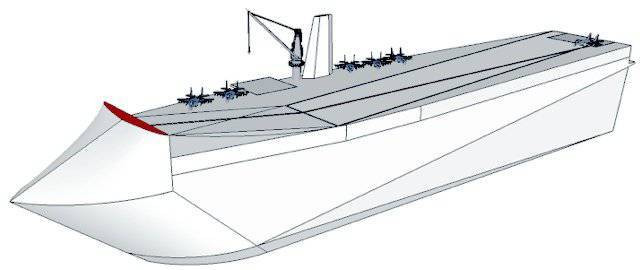
Therefore, Brazil is not in a hurry to design (more precisely, order design on the side) aircraft carriers, and carefully examines the experience of others. And this is not only the United States and France, with which Brazilian sailors and aviators have long-standing ties, but also ... the Chinese. The Brazilians, as they say, have already noted at Liaoning, where they advised the locals on the organization of flights on an aircraft carrier, and in practice got acquainted with the STOBAR concept ship. Far-reaching conclusions have not yet been made, but the experimental status of the ship, whose sistership in Russia is the flagship of the fleet, already speaks volumes, and the plans of India and China will sooner or later begin to build "normal" aircraft carriers.
As for the technical difficulties of building the new Brazilian aircraft carriers, they are in fact not present. The country is not included in the blocks, maintains good relations with all the leading powers, so that if it comes to business, they will be helped by the whole world. Not for free, of course. But Russia is unlikely to get something from this: even the Indians swore at the breakdown in the delivery of materials for the new Vikranta, the story of Vikramadity is heard, as well as the reviews about the notorious Russian quality. We would have to start and finish the planned Kuznetsov repair without loss ...
Information